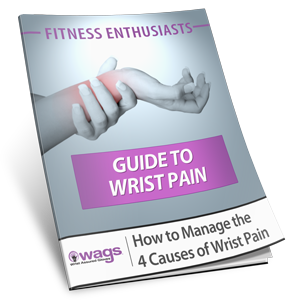Is wrist pain interfering with your yoga practice or Pilates workout? This post series details the causes of wrist pain in Part I of this series. Part II of the series can be found here.
Wrist Pain:
Our hands, by design, were not intended for weight bearing activities, so it’s no wonder that many of us experience pain or discomfort when assuming those Pilates or yoga positions that require us to do just that – bear body weight on our hands. Discomfort may simply be a result of mild limitations in wrist range of motion, improper alignment of shoulders, arms and hands or reduced core and arm strength.
Gentle and gradual stretching and strengthening exercises, along with proper body alignment and weight distribution may reduce your wrist discomfort in weight bearing positions. However, for some of us, even with good strength and proper form wrist pain persists. A close look at the anatomy of the hand reveals why wrist pain may develop.
The hand is designed more for mobility than stability. It is composed of 27 small bones, muscles and ligaments that allow for a large amount of movement and dexterity, enabling us to perform a multitude of daily activities requiring fine precision and coordination. The two bones of the lower arm, the radius and ulna, meet at the carpal bones of the hand to form the wrist. Unlike the foot the hand does not have a large bone cushioned with a fat pad for bearing weight, but has small bones surrounded by soft tissue, including the nerve and blood supply. The median nerve crosses the wrist through the carpal tunnel. These soft tissues of the wrist, including the ligaments and tendons, are subject to strain when we are weight bearing on a fully extended wrist such as in a push-up position.
The Culprits:
As a simplification, the common causes of wrist pain are grouped into 4 categories:
1.) Overuse: too much repetitive movement or joint impact.
2.) Injury: wrist fractures, strains & sprains
3.) Lack of conditioning: weak muscles, poor range of motion, improper form
4.) Aging or Disease: arthritic changes in the joints, inflammation, diabetes etc.
Which category does your wrist pain originate from?
Overuse:
One common cause of wrist pain is Overuse, clinically known as RSI– Repetitive Stress (or Strain) Injury. Long periods performing the same movements, such as typing on a computer, playing a musical instrument or doing sun salutations, can lead to RSI. Carpal Tunnel Syndrome (CTS) a leading cause of wrist pain is grouped in the RSI category.
What do you do about RSI?
An important first step in treating an overuse injury is to rest — stop doing what is causing you pain to allow healing time. The reality, however, is that many of our repetitive movements are related to our livelihood such as data input, graphic design, dental hygiene, massage therapist or fitness instructor, so to stop completely might result in a few bounced checks. If complete rest isn’t an option, two ways to decrease repetitive joint stress are through task and schedule modification. Wearing wrist support gloves during yoga, Pilates and other workouts could also help with pain.
Read more this weekend as we continue the second part of this series!






